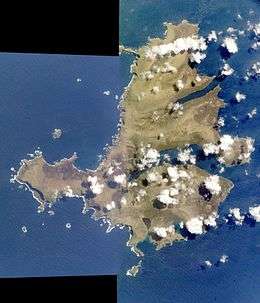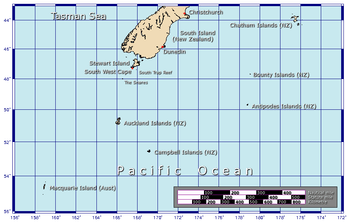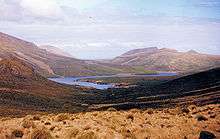Campbell Island, New Zealand
 Satellite view | |
 Location of Campbell Island | |
| Geography | |
|---|---|
| Location | Southern Ocean |
| Coordinates | 52°32′24″S 169°8′42″E / 52.54000°S 169.14500°E |
| Archipelago | Campbell Island group |
| Area | 112.68 km2 (43.51 sq mi) |
| Administration | |
|
New Zealand | |
| Demographics | |
| Population | uninhabited |
Campbell Island / Motu Ihupuku is an uninhabited subantarctic island of New Zealand, and the main island of the Campbell Island group. It covers 112.68 square kilometres (43.51 sq mi) of the group's 113.31 km2 (43.75 sq mi), and is surrounded by numerous stacks, rocks and islets like Dent Island, Folly Island (or Folly Islands), Isle de Jeanette-Marie, and Jacquemart Island, the latter being the southernmost extremity of New Zealand. The island is mountainous, rising to over 500 metres (1,640 ft) in the south. A long fjord, Perseverance Harbour, nearly bisects it, opening out to sea on the east coast.
Campbell Island is a UNESCO World Heritage Site.
History

Campbell Island was discovered in 1810 by Captain Frederick Hasselborough of the sealing brig Perseverance, which was owned by shipowner Robert Campbell's Sydney-based company Campbell & Co. (whence the island's name).[1] Captain Hasselborough was drowned on 4 November 1810 in Perseverance Harbour.
The island became a seal hunting base, and the seal population was almost totally eradicated. The first sealing boom was over by the mid-1810s. The second was a brief revival in the 1820s. The whaling boom extended here in the 1830s and ’40s. In 1874, the island was visited by a French scientific expedition intending to view the transit of Venus. Much of the island’s topography is named after aspects of, or people connected with, the expedition. In the late 19th century, the island became a pastoral lease. Sheep farming was undertaken from 1896 until the lease, along with the sheep and a small herd of cattle, was abandoned in 1931 because of the Great Depression.[2]
In 1907, a group of scientists spent eight days on the island group surveying. The 1907 Sub-Antarctic Islands Scientific Expedition conducted a magnetic survey and also took botanical, zoological and geological specimens.
During World War II, a coastwatching station was operative at Tucker Cove at the north shore of Perseverance Harbour as part of the Cape Expedition program. After the war, the facilities were used as a meteorological station until 1958, when a new one was established at Beeman Cove, a few hundred metres further east.
In April 1992, a group of meteorological staff from New Zealand were swimming when one of them was attacked and partly eaten by a great white shark. Jacinda Amey, one of the workers, swam back to rescue him while the shark was still in the area. She towed him to the shore where first aid was applied. He was rescued by a helicopter from Taupo which was guided by a twin-engine plane with satellite navigation, which was (and still is) the longest ever single-engine helicopter rescue in the world. The victim survived and Amey was awarded the New Zealand Cross, New Zealand’s highest bravery medal for civilians. The station was manned permanently until 1995 when a fully automatic station was established. Today, human presence is limited to periodic visits by research and conservation expeditions.
Following the passage of the Ngai Tahu Claims Settlement Act 1998, the name of the island was officially altered to Campbell Island / Motu Ihupuku.[3]
An amateur radio DXpedition organised by the Hellenic Amateur Radio Association of Australia visited Campbell Island during November–December 2012. The team consisted of ten amateur radio operators from around the world, a NZ Department of Conservation Officer and the ship's crew of six including the captain on the sailing vessel "Evohe". The ZL9HR DXpedition team made 42,922 on air contacts during an eight-day operating period.
The legend of The Lady of the Heather
The Lady of the Heather is the title of a romantic novel by Will Lawson. The novel is a mixture of facts and fiction elaborating on the incidents surrounding Captain Hasselburg’s death on Campbell Island. The story is about a daughter of Bonnie Prince Charlie, exiled to Campbell Island after she is suspected of treachery to the Jacobite cause.[4] Her character was inspired by Elizabeth Farr.[5] Farr was probably what would now be called a “ship girl”, but the presence of a European woman at this remote place, and her death, gave rise to The Lady of the Heather story.[6]
The accident happened when William Tucker was present on the Aurora. Tucker was another unusual character in the sealing era who became the source of a legend and a novel.[7] The remoteness and striking appearance of the sealing grounds, whether on mainland New Zealand or the subantarctic islands, and the sealing era’s early place in Australasia’s European history, supply the elements for romance and legend which are generally absent in the area’s colonial history.
Climate
Campbell Island has a maritime tundra climate (Köppen ET). The island receives only 647 hours of bright sunshine annually and it can expect less than an hour’s sunshine on 215 days (59%) of the year. The peaks of the island are frequently obscured by clouds. It has an annual rainfall of 1,329 millimetres (52.3 in), with rain, mainly light showers or drizzle, falling on an average of 325 days a year. It is a windy place, with gusts of over 96 kilometres per hour (50 kn; 60 mph) occurring on at least 100 days each year. Variations in daily and annual temperatures are small with a mean annual temperature of 7 °C (44.6 °F), rarely rising above 12.1 °C (53.8 °F). The warmest temperature ever recorded was 21.2 °C (70.2 °F) and the coldest was −7.9 °C (17.8 °F). [8]
| Climate data for Campbell Island | |||||||||||||
|---|---|---|---|---|---|---|---|---|---|---|---|---|---|
| Month | Jan | Feb | Mar | Apr | May | Jun | Jul | Aug | Sep | Oct | Nov | Dec | Year |
| Record high °C (°F) | 21.2 (70.2) |
19.3 (66.7) |
16.1 (61) |
15.8 (60.4) |
12.4 (54.3) |
11.3 (52.3) |
10.3 (50.5) |
10.4 (50.7) |
12.7 (54.9) |
15.4 (59.7) |
18.3 (64.9) |
20.0 (68) |
21.2 (70.2) |
| Average high °C (°F) | 12.1 (53.8) |
12.0 (53.6) |
11.0 (51.8) |
9.7 (49.5) |
8.3 (46.9) |
7.3 (45.1) |
6.9 (44.4) |
7.4 (45.3) |
8.0 (46.4) |
8.9 (48) |
9.8 (49.6) |
11.4 (52.5) |
9.4 (48.9) |
| Daily mean °C (°F) | 9.6 (49.3) |
9.5 (49.1) |
8.7 (47.7) |
7.6 (45.7) |
6.1 (43) |
5.1 (41.2) |
4.9 (40.8) |
5.2 (41.4) |
5.7 (42.3) |
6.4 (43.5) |
7.1 (44.8) |
8.7 (47.7) |
7.0 (44.6) |
| Average low °C (°F) | 7.1 (44.8) |
7.1 (44.8) |
6.4 (43.5) |
5.6 (42.1) |
4.0 (39.2) |
3.0 (37.4) |
3.0 (37.4) |
3.1 (37.6) |
3.5 (38.3) |
3.9 (39) |
4.4 (39.9) |
6.1 (43) |
4.8 (40.6) |
| Record low °C (°F) | 2.9 (37.2) |
2.3 (36.1) |
0.5 (32.9) |
0.0 (32) |
−3.2 (26.2) |
−6.5 (20.3) |
−7.9 (17.8) |
−6.4 (20.5) |
−4.2 (24.4) |
−1.4 (29.5) |
−1.2 (29.8) |
3.2 (37.8) |
−7.9 (17.8) |
| Average precipitation mm (inches) | 112 (4.41) |
106 (4.17) |
122 (4.8) |
115 (4.53) |
131 (5.16) |
104 (4.09) |
106 (4.17) |
103 (4.06) |
113 (4.45) |
110 (4.33) |
100 (3.94) |
108 (4.25) |
1,329 (52.32) |
| Average precipitation days (≥ 1 mm) | 21 | 19 | 27 | 28 | 20 | 18 | 22 | 27 | 25 | 30 | 24 | 29 | 290 |
| Mean monthly sunshine hours | 74.8 | 72.4 | 66.4 | 48.6 | 39.4 | 29.2 | 31.3 | 34.5 | 52.2 | 63.4 | 62.9 | 72.2 | 647.3 |
| Source #1: NIWA National Climate Database[9] | |||||||||||||
| Source #2: Extreme temperatures around the world. http://www.mherrera.org/temp.htm (June 2015) | |||||||||||||
Flora and fauna
Coleoptera
- Carabidae
- Kenodactylus audouini
- Oopterus clivinoides
- Oopterus marrineri [endemic]
- ?Laemostenus complanatus [introduced, established?]
Important Bird Area
Campbell Island is the most important breeding area of the southern royal albatross. The island is part of the Campbell Island group Important Bird Area (IBA), identified as such by BirdLife International because of its significance as a breeding site for several species of seabirds as well as the endemic Campbell teal and Campbell snipe.[10]
Remotest tree
The world's most remote tree is believed to be on Campbell Island, a solitary 100-year-old Sitka spruce. The nearest tree is over 222 km away on the Auckland Islands.[11][12][13]
Conservation
In 1954, the island was gazetted as a nature reserve. Feral Campbell Island cattle were eliminated by about 1984 and feral Campbell Island sheep were culled during the 1970s and 1980s, with their eventual extermination in 1992. In 2001, brown rats (Norway rats) were eradicated from the island nearly 200 years after their introduction. This was the world’s largest rat eradication programme. The island’s rat-free status was confirmed in 2003.[8] Since the eradication, vegetation and invertebrates have been recovering, seabirds have been returning and the Campbell teal, the world’s rarest duck, has been reintroduced.[14] Other native landbirds include the New Zealand pipit and the Campbell snipe, a race or species of the Coenocorypha snipes discovered only in 1997. The snipe had survived on Jacquemart Island and began recolonising the main island after the rats had been removed.
Marine mammals have shown gradual recovery in the past decades. Sea lions and southern elephant seals have begun to re-colonize the island.[15] Some southern right whales still come into bays in the winter to winter or calve most notably at Northwest Bay and Perseverance Harbour,[16] but in much smaller number than in the Auckland Islands.[17] Historically, fin whales used to inhabit close to shore.[18]
The area is one of five subantarctic island groups designated as a World Heritage Site by UNESCO.[19]
Research
To mark the 200th anniversary of its discovery, the Campbell Island Bicentennial Expedition (CIBE) was undertaken from December 2010 to February 2011. The research expedition was the largest multidisciplinary expedition to the island in over 20 years, and aimed to document the island’s human history, assess recovery of the island’s flora and invertebrate fauna since the removal of sheep and the world’s largest rat eradication programme, study the island’s plentiful but little understood streams and characterise the unusual stream fauna, and reconstruct past environmental conditions and deduce long term climate change from tarn sediment cores.
The expedition was run by the 50 Degrees South Trust, a charitable organisation established to further research and education on New Zealand’s Subantarctic Islands, and to support the preservation and management of these World Heritage ecosystems. The expedition and the programme outputs can be followed at the CIBE website.
See also
- Campbell teal
- Megaherbs
- Campbell Island group
- New Zealand subantarctic islands
- List of Antarctic and subantarctic islands
- Rat Island, where rats have also been eradicated
References
- ↑ The Antarctic Dictionary
- ↑ Ian S. Kerr, Campbell Island, a History, Wellington: A.H. & A.W. Reed,1976.
- ↑ "Ngai Tahu Claims Settlement Act 1998". Retrieved 28 March 2016.
- ↑ "Tekeli-li" or Hollow Earth Lives: A Bibliography of Antarctic Fiction
- ↑ Tragic Drownings at Campbell Island, The Sealer's Shanty
- ↑ Lawson, Will, The Lady of the Heather, Angus and Robertson Ltd., Sydney & London 1945 (First Edition Oswald-Sealy (NZ) Ltd, )
- ↑ Peter Entwisle, Taka: a Vignette Life of William Tucker 1784-1817, Dunedin: Port Daniel Press, 2005, ISBN 0-473-10098-3, pp.73-75.
- 1 2 NZ Govt report on eradication of Norway rats
- ↑ "NIWA National Climate Database".
- ↑ BirdLife International. (2012). Important Bird Areas factsheet: Campbell Island (and outliers). Downloaded from "Archived copy". Archived from the original on 2007-07-10. Retrieved 2013-08-31. on 2012-01-22.
- ↑ Guinness Book of World Records. Guinness World Records Limited. 2013. p. 41. ISBN 9781904994862.
- ↑ The Lone Tree of Campbell Island – Sub-Antarctic Science. Subantarcticscience.wordpress.com (2012-04-13). Retrieved on 2013-08-02.
- ↑ Blog and News from. the Centre for Science Communication (2012-02-15). Retrieved on 2013-08-02.
- ↑ "DOC's work with subantarctic teal - Recent conservation efforts". Department of Conservation.
- ↑ Antonvanhelden (2012). "Our Far South". Museum of New Zealand Te Papa Tongarewa. Retrieved 2015-01-05.
- ↑ http://tiamaexpeditions.com/wp-content/uploads/2015/06/2014-Campbell-Island-Southern-Right-Whale-Survey.pdf
- ↑ Stewart R., Todd B. (2001). "A note on observations of southern right whales at Campbell Island, New Zealand" (PDF). Journals of Cetacean Research Management Special Issue 2 (2001): 117–120. Retrieved 2014-07-09.
- ↑ Gaskin, D.e. (1968). "The New Zealand Cetacea(pdf), Fisheries Research Bulletin No.1(New Series)" (PDF). New Zealand Marine Department. p. 24.
- ↑ New Zealand Sub-Antarctic Islands - UNESCO World Heritage Centre
Gallery
 Vagrant adolescent male elephant seal Mirounga leonina resting in the tussock grasses
Vagrant adolescent male elephant seal Mirounga leonina resting in the tussock grasses New Zealand sea lions disporting themselves among the tussock grass
New Zealand sea lions disporting themselves among the tussock grass Campbell Island landscape (taken during an unusually warm and dry late summer)
Campbell Island landscape (taken during an unusually warm and dry late summer)_with_chick_on_Campbell_Island.jpg) Southern royal albatross, Diomedea epomophora with chick on mound nest on Campbell Island
Southern royal albatross, Diomedea epomophora with chick on mound nest on Campbell Island Campbell Island landscape with a megaherb community in the foreground
Campbell Island landscape with a megaherb community in the foreground Southern royal albatross in flight
Southern royal albatross in flight Pair of southern royal albatrosses
Pair of southern royal albatrosses SW Bay
SW Bay Six Foot Lake
Six Foot Lake
External links
| Wikimedia Commons has media related to Campbell Island. |
- Topographic map, Campbell Island, NZMS 272/3, Edition 1, 1986.
- Long description of Campbell Island and especially its history
- Landcare Research - Campbell Island
- Campbell Island Bicentennial Expedition
- Campbell Island Freshwater Invertebrate Identification Keys
Coordinates: 52°32.4′S 169°8.7′E / 52.5400°S 169.1450°E